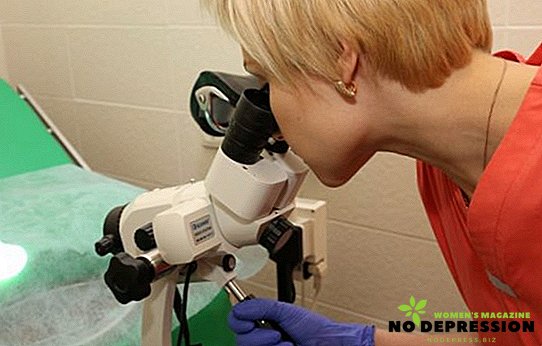A cervical colposcopy is a common gynecological procedure that is recommended for all women on a regular basis. With its help, it is possible to obtain information about the state of the vagina and cervix and diagnose cancer. The procedure is carried out with the use of a special device and in the detection of suspicious formations, abnormal cells are immediately collected for further laboratory research.

What is colposcopy in gynecology
When conducting colposcopy specialist examines the body with the help of such a special tool as a colposcope. This procedure allows women to identify various pathologies of both gynecological and oncological nature.
Colposcopy of the cervix is shown in various female diseases, among the variety of which can be identified erosion, cervical polyps and malignant tumors.
Types of colposcopy of the cervix
 In medical practice, simple and extended colposcopy is used.
In medical practice, simple and extended colposcopy is used.
Using a simple survey, it is possible to visually assess the surface of the cervix, its size and shape. In addition, this procedure allows you to carefully consider the cervical canal with the establishment of the boundaries of the flat and high cylindrical epithelium.
Extended colposcopy involves treating the cervix with a solution of acetic acid and then with a solution of Lugol. This procedure allows us to distinguish the normal state of the tissues from the diseased ones. In addition, an extended examination greatly facilitates the selection of a biopsy zone.
When a procedure is prescribed
When colposcopy is carried out gynecological examination of the patient in the chair, during which the state of the cervix and vagina is examined. The study is performed using a colposcope, with which it is possible to carefully examine the tissue. In addition, such a diagnostic method is often prescribed to identify various pathologies of the reproductive organs and confirm the earlier diagnoses.
The main task of colposcopy is to diagnose abnormal tissues and promptly distinguish a malignant tumor from a benign tumor. An indication for such a study may be the need to monitor the effectiveness of conservative therapy.
It is necessary to undergo colposcopy for the following symptoms:
- worried about severe itching in the vagina and abundant discharge from the genitals;
- nagging pain localized in the lower abdomen;
- pain syndrome after sexual contact;
- bleeding from the genitals.
The indication for colposcopy is considered to be a poor smear analysis, when the indicators do not correspond to the norm.
Recommendations when preparing

Before colposcopy, some preparation is necessary:
- for 2-3 days it is recommended to refuse sex life;
- do not take vaginal baths for several days and do not use tampons and candles;
- in case of hypersensitivity, any anesthetic is allowed to drink before the procedure.
The whole procedure lasts 10-20 minutes, and when it is performed, the patient lies in a gynecological chair. During the study, the specialist inserts a mirror into the vagina, which may cause a woman some discomfort. After that, the doctor next to the gynecological chair has a colposcope, with which it is possible to examine the organs enlarged.
To diagnose pathological changes in the mucous membrane, the gynecologist can treat the neck with an aqueous solution of iodine or vinegar. When in contact with such a solution, healthy cells become dark brown, and pathological cells retain their former appearance. If abnormal areas are detected, a specialist can perform a biopsy by taking a tissue sample for examination.
Using the colposcope, it is possible to identify even the smallest changes at the initial stage, as well as to determine the location and complexity of the pathology. During the study, the doctor assesses the structure of the mucous membrane and its appearance.
When conducting a simple colposcopy, there are usually no restrictions and unpleasant consequences. The appearance of dark discharge after the extended procedure is possible, but this is considered normal. For several days after colposcopy, slight bleeding may occur, which passes on its own.
The results of colposcopy of the cervix
Decoding the results of cervical examination is carried out only by a specialist.
All results obtained are classified as follows:
- background processes (hyperplastic, post-traumatic and inflammatory);
- precancerous changes (dysplasia of various degrees, adenomatosis and atypical leukoplakia);
- oncology of the cervix.

Primarily in the results of colposcopy, the following terms are found:
- flat and cylindrical epithelium;
- ectopia;
- transformation zone
- metaplastic epithelium
- acetowhite epithelium;
- iodine - negative sites;
- atypical vessels;
- metaplasia;
- condylomas;
- mosaic;
- punctuation.
In addition, the results indicate such anomalies as endometriosis, polyps and expressions.
What to do after the procedure
After the usual colposcopy, the patient can return to the usual way of life. For several days it is recommended to use sanitary napkins to make sure that vaginal discharge is complete. Usually after the procedure for 1-2 days, there may be weak spotting, but this is extremely rare.
In the event that the patient underwent a colposcopy with a biopsy, then after her 10 days it is forbidden to take baths and carry out any thermal procedures. In addition, it is forbidden to have sex, douche and engage in heavy physical labor. A tampon inserted into the vagina to stop bleeding should be removed the next day. Usually, after the procedure, there are no complications, with the exception of pain in the lower abdomen, which disappear after a few days.
To whom and when colposcopy is contraindicated

Colposcopy is considered a simple and safe method of research, therefore there are minimum contraindications for its implementation. The only limitation is menstrual bleeding, that is, the procedure is not allowed during monthly periods. It is not recommended to use such a diagnostic method for the inflammatory process in the acute form and for atrophy of the ectocervix. The procedure should be abandoned in the first months after childbirth, abortion, surgery on female organs and in case of hypersensitivity to reagents.
The most suitable period for the procedure is the first half of the cycle. Experts recommend doing colposcopy of the cervix for 2-3 days after the end of menstruation.
It is not prohibited to perform such a study on other days of the cycle, but in addition to the period of menstrual bleeding. After the release of the egg from the ovary, an abundant amount of mucus accumulates in the cervical canal, which can affect the results. In the second half of the cycle, the rate of tissue regeneration slows down, and this often provokes the appearance of minor pain sensations.
Possible complications

Such a procedure as colposcopy is considered to be fairly safe, but in rare cases some complications may develop. Sometimes after examination a woman has a slight mucous discharge with blood. In addition, dark brown and greenish secretions, which are complemented by the aching painful sensations of a spastic nature in the lower abdomen, may disturb.
Complications after colposcopy are quite rare and are mainly represented by an infectious process. Perhaps bleeding after a biopsy or an allergic reaction to the funds that were used during the procedure.
It is necessary to consult a specialist as soon as possible when the following symptoms appear:
- copious bloody discharge that does not stop during the day;
- rise in body temperature;
- pronounced pain, localized in the lower abdomen;
- discharge with admixture of pus from the genitals;
- chills and severe weakness;
- bleeding that does not stop more than five days.
The appearance of such symptoms may indicate a strong inflammatory process occurring in the genitals.

Reviews
Elena, 34, Moscow
A colposcopy was prescribed to me by a doctor when my cervix erosion was detected. In fact, the procedure is completely innocuous and is an ordinary gynecological examination, but using a colposcope. After colposcopy, I led a normal life and did not experience any discomfort.
Irina, 21, Saratov
I undergo colposcopy every six months, since for several years I have been treating cervical dysplasia. The procedure is quite ordinary and no different from the usual inspection. A slight discomfort occurs when a colposcopy is performed simultaneously with a biopsy.












